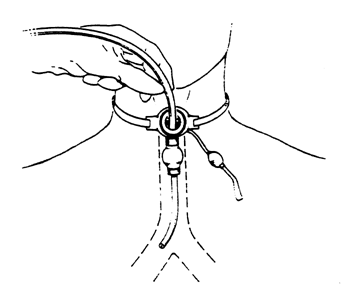What other treatments may be used?
Many treatments are available to assist and heal those with brain injury.
Tracheostomy

Initially the patient will be unable to talk while the trach is in place. As the patient improves, a talking trach may be used. A trach is usually not permanent.
Additional treatment for brain injuries
Suctioning of the stomach
Sometimes after brain injury, the stomach will stop working for a short time. This is called an ileus. Even though the stomach may not be working it continues to make acid. The acid may damage the stomach lining and cause stomach ulcers if they are not removed. A nasogastric tube (NG) will be placed through the nose into the stomach. This tube will be used to help remove stomach secretions. Medications may also be given to help prevent stomach ulcers.
Nutrition
Meeting nutrition and fluid needs is important after brain injury. Patients may be less active, yet have very high nutritional needs. At first, nutrition may be supplied by an IV. When the stomach starts working, an evaluation of chewing and swallowing safety will be completed. If the patient is too sleepy to eat, or unable to swallow, a small nasogastric feeding tube may be used for nutrition. The tube is placed through the nose into the stomach. Liquid formula will be given through the feeding tube. Feedings may be given continuously or several times a day.
The dietician will assist with food and fluid selection. Milkshakes and liquid formulas may also be used to provide extra calories and high protein nutrition. A feeding tube may be used if the patient continues to be too sleepy to eat or unable to swallow. A gastrostomy tube is a feeding tube that goes in the stomach. A jejunostomy tube is a feeding tube that goes in the intestine.
Bowel and bladder care
Patients may not have control of their bowel or bladder. Catheters or diapers will be used until bowel and bladder control returns.
Skin care
Some things that help prevent bedsores include turning the patient, padding equipment, keeping skin clean and dry, using special mattresses, and making sure the patient gets enough calories.
Range of motion (ROM) and splints
Patients with brain injury may not be able to move their joints as much as needed. This can cause tight muscles and joints called contractures. Range of motion (ROM) exercises and special splints for hands and feet help prevent contractures.
Pain control
Comfort measures and medication will be used for pain control. However, medications may be limited to types that do not cause drowsiness.